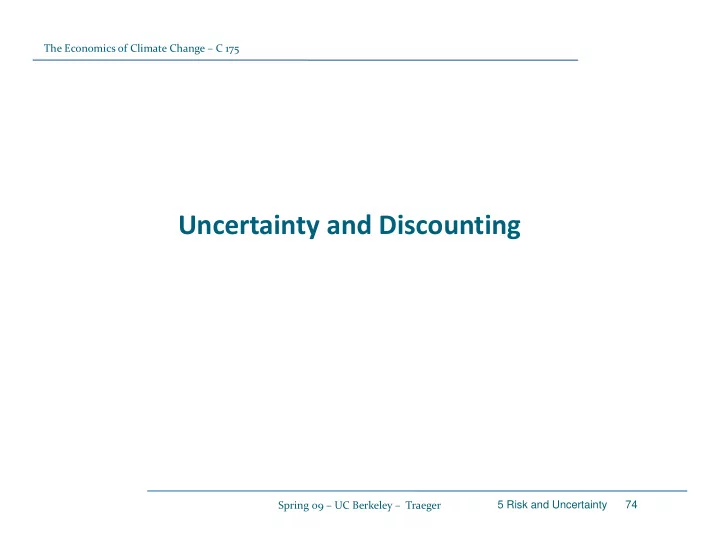

The Economics of Climate Change – C 175 Uncertainty and Discounting Spring 09 – UC Berkeley – Traeger 5 Risk and Uncertainty 74
The Economics of Climate Change – C 175 Uncertainty and Discounting Assume the real rate of interest/productivity is uncertain (Few risk ‐ free investments beyond say 30 years exist) Find the certainty equivalent discount rate to evaluate costs and benefits i d h i i l di l d b fi of climate policy Example: Current rate of 4% can rise to 7% or decline to 1% over the next 100 years Source: Newell, R. and W. Pizer (2001), “Discounting the benefits of climate change mitigation: How much do uncertain rates increase valuation” PEW center valuation , PEW center, Economics technical series. Spring 09 – UC Berkeley – Traeger 5 Risk and Uncertainty 75
The Economics of Climate Change – C 175 Uncertainty and Discounting In 100 years $100 is worth $20.28 (lower path) or $0.20 (higher path) Assume they are equally likely: Expected value: $10.24 In 101 years 0 yea s $100 is worth $20.28/1.01=$20.08 (low path) or $0.20/1.07=0.19 (high path) Expected value: $10.13=0.5 $20.08 + 0.5 $0.19 Effective certainty equivalent discount rate $10.24 / $10.13 = 1.01 = 1+r [ equivalent to $10.13 = $10.24/(1+r) ] 4 / 3 [ q 3 4/( ) ] Effective Discount rate r=1% is determined by smaller discount rate Reason: large discount rate heavily discounts future benefits such that it adds little to the expected value it adds little to the expected value Spring 09 – UC Berkeley – Traeger 5 Risk and Uncertainty 76
The Economics of Climate Change – C 175 Uncertainty and Discounting British Green Book prescribes for evaluation of long term cost and benefits declining (‘hyperbolic’) discount rates: stating that “The main rationale for declining long ‐ term discount rates results from uncertainty about the future. “ Source: HM Treasury (2003), The Green Book – Appraisal and Evaluation in Central Government, HM Treasury, London. However, this reasoning on discounting and uncertainty does not take into consideration learning ‐ > More complicated! (current research) > More complicated! (current research) Spring 09 – UC Berkeley – Traeger 5 Risk and Uncertainty 77
Recommend
More recommend